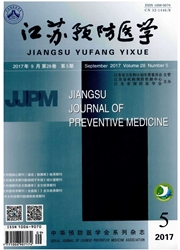

 中文摘要:
中文摘要:
目的了解碘缺乏重点地区不同人群的碘营养现状。方法在23个碘缺乏重点县(市、区),随机抽取2 303份盐样,2 239份儿童、育龄妇女及孕妇和哺乳妇女尿样,检测盐碘含量和尿碘浓度。结果碘盐覆盖率,碘盐合格率,合格碘盐食用率分别为98.3%、97.6%、95.0%;学龄儿童和育龄妇女尿碘中位数分别为240.1μg/L、231.8μg/L,略高于适宜范围但未过量,孕妇和哺乳妇女尿碘中位数均在150~249μg/L适宜范围。结论碘缺乏重点地区重点人群碘营养总体上充足,建议加强对各类特需人群的碘营养水平监测。
 英文摘要:
英文摘要:
Objective To investigate the iodine nutrition status of different population in key iodine deficiency areas. Methods A total of 2 303 salt samples were gathered randomly and 2 239 urine samples came from children, childbearing women, pregnant women and lactating women. Iodized salt content and urinary iodine concentration were measured. Results The coverage and qualified rate of iodized salt and qualified iodized salt consumption rates were 98.3%, 97.6% and 95.0%, respectively. The median concentrations of urinary iodine among children and childbearing women were 240.1 μg/L and 231.8 μg/L respectively, within the range of above sufficient level but not in the excessive range. The median concentrations of urinary iodine among pregnant and lactating women were at a sufficient iodine level of 150-250 /μg/L. Conclusion The overall level of iodine nutrition of population in the key iodine deficiency areas is adequate. Surveillance on iodine nutrition status of different population should be strengthened.
 同期刊论文项目
同期刊论文项目
 同项目期刊论文
同项目期刊论文
 期刊信息
期刊信息
